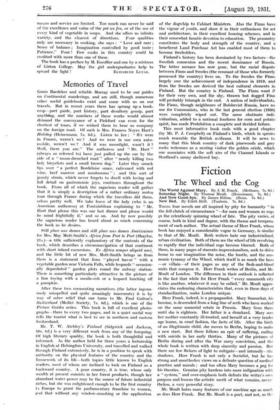Memories of Travel
Goon Baedeker and reliable Murray used to be our guides on Continental wanderings, and are still, though numerous other useful guidebooks exist and come with us on our travels. But in recent years there has sprung up a book- crop—part guide, part history, part desultory gossip, part anything, and the numbers of these works would almost demand the conveyance of a Pickford van even for the shortest of tours, if we wished them to bear us company on the foreign road. Of such is Mrs. Frances Noyes Hart's Holiday (Heinemann, 7s. 6d.). Listen to her : " We were in France, weren't we ? And we were in our own auto- mobile, weren't we ? And it was moonlight, wasn't it ? Well, there you are." The authoress and "Mr. Hart" (always so referred to) have just pulled up the car by the side of a "moon-drenched road" after "nearly killing two lady bicyclists and a small brown dog." Later they smack lips over "a perfect Bordelaise sauce, enlivened with red wine, beef marrow and mushrooms " ; and this sort of jaunty strain, which never forgets to dwell with loving and full detail on gastronomic joys, continues throughout the book. From all of which the sagacious reader will gather that it is simply a description of a rather ordinary motor tour through France during which the travellers did them- selves pretty well. We take leave of the lady (who is an American authoress) at Fontainbleau explaining to "Mr. Hart that please this was our last dinner and please would he mind frightfully if," and so on. And by now possibly the sagacious reader has heard about as much concerning the book as he desires.
Still place aux dames and still place awe dames Americaines for Mrs. May Mott-Smith's Africa from Port to Port (Shaylor, 21s.)—a title sufficiently explanatory of the contents of the book, which describes a circumnavigation of that continent with short inland excursions. Ex Africa semper aliquid novi, and the little bit of new Mrs. Mott-Smith brings us from there is a statement that lions "played havoc" with a vegetable garden near Victoria Falls, while leopards" occasion- ally depredated" garden plots round the railway station. There is something particularly attractive in the picture of a lion toying with a mealie-cob or a leopard lunching off a pumpkin.
After these two coruscating narratives (the latter ingenu- ously misspelled and quite amazingly inaccurate) it is by way of sober relief that one turns to Mr. Paul Guiton's Switzerland (Medici Society, 7s. 6d.), which is one of the Picture Guides series. This book is full of excellent photo- graphs—three to every two pages, and in a quiet useful way tells the tourist what is best to see in northern and eastern Switzerland.
Mr. T. W. Atchley's Finland (Sidgwick and Jackson, 10s. 6d.) is a very different work from any of the foregoing. Of high literary quality, the book is both thoughtful and informed. As the author held for three years a lectureship in English at Helsingfors University, and travelled and walked through Finland extensively, he is in a position to speak with authority on the physical features of the country and the framework of its life—both topics little known to English readers, most of whom are inclined to look on Finland as a backward country. A poor country, it is true, whose only wealth at present consists in her forest products, though her abundant water power may be the source of future industrial riches, but she was enlightened enough to be the first country is Europe to grant the parliamentary franchise to women, and that without any window-smashing or the application
of the dogwhip to Cabinet Ministers. Also the Finns have the vigour of youth, and show it in their enthusiasm for art and architecture, in their excellent housing schemes, and in their somewhat fanatic devotion to education. The peasantry constitutes the body and strength of the country, and a beneficent Land Purchase Act has enabled most of them to become freeholders.
Finland's history has been dominated by two factors—the Swedish connexion and the recent dominance of Russia. The latter menace has now gone, but the racial dispute between Finns and Swedes (the remnant of those who formerly possessed the country) lives on. To the Swedes the Finns largely owe the achievement of independence in 1919, and from the Swedes are derived the best cultural elements in Finland. But the country is Finland. The Finns want it for their very own, and the shy, thrawn but dogged Finn will probably triumph in the end. A nation of individualists, the Finns, though neighbours of Bolshevist Russia, have no use for Communists, who in the last general election (1930) were completely wiped out. The same obstinate indi- vidualism, added to a national fondness for corn and potato spirit, has made Prohibition a complete and derided failure.
This most informative book ends with a good chapter (by Mr. P. J. Campbell) on Finland's birds, which in species much resemble the British avifauna. It will be news to many that this bleak country of dark pinewoods and grey rocks welcomes as a nesting visitor the golden oriole, which one associates with the soft airs of the Channel Islands or Studland's sunny sheltered bay.


























 Previous page
Previous page